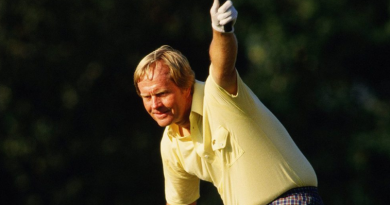Anchoring Decision Pending! *Updated*!

After months of deliberation, it looks like we’ll finally get an answer on the anchoring debate. The United States Golf Association and the R&A will jointly announce its final decision on the legality of anchoring putting at a news conference Tuesday morning at 8 a.m. The two rules-making bodies have promised a final decision this spring after a 90-day comment period ended on Feb. 28. The USGA will provide a live webcast of the press conference here. Expect to see the conference broadcast live on sports channels.
We’ve heard opinions from among players, golf writers, and really anyone at all interested in the game after the USGA and R&A proposed a ban to anchored putting strokes starting 2016. The real drama of this decision occurred when the PGA Tour and the PGA of America came out against the ban, pitting themselves against the European Tour, LPGA Tour, and other golf organizations that have said they are in favor of a ban. This also puts the the organizations that run the various majors, the USGA the U.S. Open, the R&A the Open Championship, and the PGA the Ryder Cup and PGA Championship, at odds.
Now, remember that the USGA and R&A proposed the ban after three of the previous five majors champs used either belly putters or long putters – Keegan Bradley (2011 PGA), Webb Simpson (2012 U.S. Open) and Ernie Els (2012 Open Championship). After the ban was proposed, Adam Scott then won the Masters in April using a long putter. Unsurprisingly, Scott is not in favor of the ban. “There just seems to be no logic to the whole issue and golf’s ruling bodies are going about this whole issue on a whim,” Scott claimed. Supporters of anchoring point out that the rule change is not fair to players who use anchoring, as it has been legal for 30 years. The also argue that it would limit recreational players and that anchored putting does not provide an advantage
Of course, the USGA sees it differently. “One of the most fundamental things about the game of golf is we believe the player should hold the club away from his body and swing it freely,” said Mike Davis, the executive director of the United States Golf Association, at the time the proposal was announced. “We think this is integral to the traditions of the game. Golf is a game of skill and challenge, and we think that is an important part of it.”
“The player’s challenge is to control the movement of the entire club in striking the ball, and anchoring the club alters the nature of that challenge. Our conclusion is that the Rules of Golf should be amended to preserve the traditional character of the golf swing by eliminating the growing practice of anchoring the club.”
The PGA of America argues that the ban would hurt their efforts to grow the game. Even though only 15% of Tour players use an anchored stroke, PGA Tour commissioner Tim Finchem also came out against the ban in order to support his players.
If the USGA and R&A do adopt the ban, it will most likely take effect in the next scheduled rule update on Jan 1. 2016. No one looks keen to have two separate set of rules, but Finchem has declined to say whether the PGA Tour would enforce the ban.
Keep your eyes here Rock Heads for the any updates come Tuesday!
……UPDATE AS OF TUESDAY MORNING!…..
The USGA and R&A this morning announced that the anchored stroke will no longer be allowed, beginning in 2016. They released this press statement:
USGA AND THE R&A ANNOUNCE FINAL APPROVAL OF RULE 14-1B THAT PROHIBITS USE OF ANCHORED STROKES
Governing Bodies Issue Report Explaining Their Decision Following Comment Process New Rule to Take Effect on January 1, 2016, Allowing for Transitional Period Belly-Length and Long Putters Remain as Conforming Clubs
Far Hills, N.J., USA and St Andrews, Scotland (May 21, 2013) – The United States Golf Association (USGA) and The R&A, golf’s governing bodies, today announced the adoption of Rule 14-1b of the Rules of Golf that prohibits anchoring the club in making a stroke. The new Rule will take effect on January 1, 2016, in accordance with the regular four-year cycle for changes to the Rules of Golf.
Rule 14-1b, which was proposed on November 28, 2012, has now been given final approval by the USGA and The R&A following an extensive review by both organizations. The decision to adopt the new Rule came after a comprehensive process in which comments and suggestions from across the golf community were collected and thoroughly considered.
The USGA and The R&A have prepared a detailed report to explain the reasons for the decision to adopt Rule 14-1b. The report explains the principles on which the Rules of Golf are founded, why freely swinging the entire club is the essence of the traditional method of stroke, and why anchoring is a substantially different form of stroke that may alter and diminish the fundamental challenges of the game. It points out that the Rule will still allow the use of belly-length and long putters and that a wide variety of types of strokes remain for players to use. The report concludes that the new Rule should not adversely affect participation in the game, that it is not too late or unfair to require players to comply with it and that it will remove concerns about any potential advantage that anchoring provides. It also makes clear that one set of Rules is essential to the future health of the game. The report, entitled Explanation of Decision to Adopt Rule 14-1b of the Rules of Golf, can be found at www.usga.org/anchoring or at www.RandA.org/anchoring.
“Having considered all of the input that we received, both before and after the proposed Rule was announced, our best judgment is that Rule 14-1b is necessary to preserve one of the important traditions and challenges of the game – that the player freely swing the entire club,” said USGA President Glen D. Nager. “The new Rule upholds the essential nature of the traditional method of stroke and eliminates the possible advantage that anchoring provides, ensuring that players of all skill levels face the same challenge inherent in the game of golf.”
Peter Dawson, Chief Executive of The R&A said: “We took a great deal of time to consider this issue and received a variety of contributions from individuals and organisations at all levels of the game. The report published today gives a comprehensive account of the reasons for taking the decision to adopt the new Rule and addresses the concerns that have been raised. We recognise this has been a divisive issue but after thorough consideration we remain convinced that this is the right decision for golf.”
The current Rule 14-1 of the Rules of Golf will be re-numbered as Rule 14-1a, and new Rule 14-1b will be established as follows:
14-1b Anchoring the Club
In making a stroke, the player must not anchor the club, either “directly” or by use of an “anchor point.”
Note 1: The club is anchored “directly” when the player intentionally holds the club or a gripping hand in contact with any part of his body, except that the player may hold the club or a gripping hand against a hand or forearm.
Note 2: An “anchor point” exists when the player intentionally holds a forearm in contact with any part of his body to establish a gripping hand as a stable point around which the other hand may swing the club.
Rule 14-1b will not alter current equipment rules and allows for the continued use of all conforming golf clubs, including belly-length and long putters, provided such clubs are not anchored during a stroke. The new Rule narrowly targets only a few types of strokes, while preserving a golfer’s ability to play a wide variety of strokes in his or her individual style.
The January 1, 2016, timetable for implementation also provides an extended period in which golfers may, if necessary, adapt their method of stroke to the requirements of the new Rule.
David Rickman, Executive Director of Rules and Equipment Standards at The R&A, said: “This Rule change addresses the future and not the past. Everyone who has used an anchored stroke in the past, or who does so between now and January 1, 2016, will have played entirely within the Rules and their achievements will in no way be diminished.”
“The discussion around the Rule has been very helpful, and we appreciate that so many different perspectives were offered,” said USGA Executive Director Mike Davis. “We know that not everyone will agree with the new Rule, but it is our hope that all golfers will accept that this decision is reasoned and motivated by our best judgment in defining the sport and serving the best interests of the game.”




